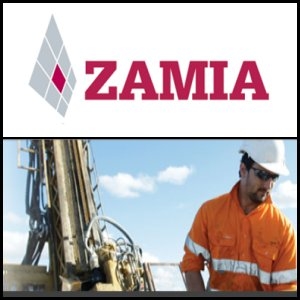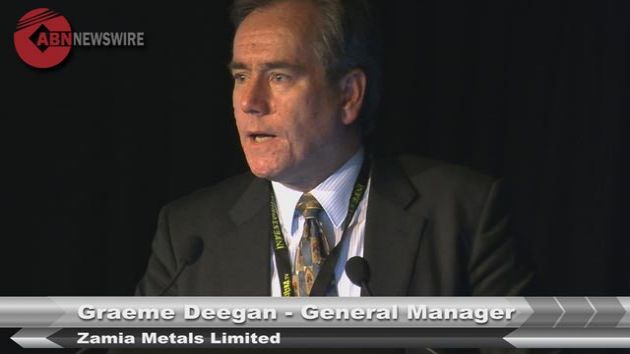 Significant Gold Intersections - Belyando Gold Project Drilling Results
Significant Gold Intersections - Belyando Gold Project Drilling Results
Sydney, Feb 25, 2015 AEST (ABN Newswire) - Zamia Metals Limited ( ASX:ZGM) Significant Gold Intersections - Belyando Gold Project Drilling Results
ASX:ZGM) Significant Gold Intersections - Belyando Gold Project Drilling Results
Highlights
- Four new percussion drill holes totalling 822 metres ('m') completed at the Belyando Project
- Significant gold intersections in 2 new drill holes collared to the north of the Belyando open cut:
* Hole RC14BY005 intersected 70m averaging 0.7 parts per million ('ppm') or grams per ton Cg/f) gold
* Holes RC14BY004 & RC14BY005 feature several 2-8m long intersections averaging above 1 ppm gold
- Elevated gold assays of up to 0.5 ppm within hole RC14BY007 reveal previously unknown south-east extent to the Belyando mineralisation system
- New intercepts demonstrate the potential for continuous gold mineralisation down-dip and along strike of the mined deposit, i.e. underneath and beyond the Belyando pit
- The three mineralised reverse circulation ('RC) drill holes were terminated prematurely due to groundwater inflow
Interpretation of Drilling Results
Gold intersections averaging above 0.5 ppm gold in holes RC14BY004 and RC14BY005 demonstrate the potential for continuing mineralisation down-dip of the deposit mined to date, accomplishing the main objective of Zamia's drilling programme. In context with previous drilling results published by Menzies Gold Ltd (1986-87) and Ross Mining NL (1988) the 70m long intersection in hole RC14BY005 suggests a zone of low-grade gold mineralisation (averaging 0.6 to 0.7 ppm) present underneath the current Belyando pit (Figure 2 in link below), with further potential existing down-dip to the north. Limited diamond drilling completed by previous explorers shows consistent gold intersections along strike to the east (Figures 3-4; see also ASX ZGM 19 August 2014) and suggests that down-dip mineralisation continues beneath the current level of mining for a minimum of 100m.
Elevated gold assays of above 0.1 and up to 0.56 ppm returned from 130-160m depth, in hole RC14BY007, i.e. approximately 200m east of the current pit margin; indicate that the Belyando mineralisation system may be more extensive along strike than previously thought. This interpretation is supported by the drill hole geology, which is identical to the one observed in drill holes RC14BY004 and RC14BY005 and rocks exposed in the Belyando pit. Of particular encouragement to Zamia is evidence for trachyte dykes (see Figure 7, in link below), which follow the geological structure localising gold mineralisation at Belyando (Mustard, 1998), and may serve as marker horizons within the otherwise monotonous phyllite sequence.
Using projected dips of two prominent trachyte dykes, exposed in the Belyando pit and identifiable on Ross Mining drill sections, Zamia has concluded that hole RC14BY005 is likely to have intersected the down-dip section of the Belyando deposit. Applying the same technique to hole RC14BY004 suggests that the hole may have fallen short of sampling the full width of down-dip mineralisation.
Zamia has earmarked the hole for future extension by diamond drilling.
Project Background
Following the cancellation of ML 2312, the area covering the post-production Belyando Gold Mine ('Belyando') located north of Clermont, Central Queensland, became part of Zamia's EPM 15145 - 'Mazeppa Extended' in May 2014 (ASX ZGM 28 May 2014). Zamia has since evaluated the potential for the discovery of new gold mineralisation at the project, based on historic exploration data (ASX ZGM 19 August 2014). As a result, the company opted for a percussion RC drilling programme, testing (a) the presence of gold mineralisation down-dip of the resource established and mined by Ross Mining NL in 1989-93 and (b) the potential for intrusion-related or porphyry-style mineralisation lateral to the open pit.
2014 Drilling Programme Details
Drilling contractors Mitchell Services Ltd completed 4 RC percussion drill holes totalling 822m in November 2014. Drill hole details are summarised in Table 1. Hole locations are shown in Figure 1.
Two-metre composite samples were assayed for gold and a suite of trace elements at A.L.S. Chemex Ltd laboratories in Brisbane. Final assays became available on January 2015. Significant gold intersections for a II holes are summarised in Table 2 in link below.
Drilling Results
Drill holes RC14BY004, RC14BY005 and RC14BY007 intersected metamorphic siltstone ('phyllite'), showing hydrothermal sericite alteration as well as moderate to intense quartz veining and sulphide mineralisation (primarily pyrite and arsenopyrite). Narrow (l-3m) intersects of clay observed in the 3 holes are interpreted as altered trachyte dykes (Figures 5-7). Both lithologies are exposed in the Belyando pit and altered phyllite is known to host the Belyando gold mineralisation (Mustard, 1998).
All three holes ended in sulphide-bearing quartz reef and were terminated due to ground water influx. Zamia may choose to extend any of the drill holes in the future, using diamond drilling.
Holes RC14BY004 and 5 encountered several 2-8m long gold intersections assaying between 1 and 3 ppm. Longer intersections assaying below 1 ppm gold are common in both drill holes and hole RC14BY005 features a significant intersection of 70m length, averaging 0.7 ppm gold (Table 2 in link below).
Hole RC14BY007 features consistent elevated gold assays (>0.1 ppm) from 130m down-hole, including a best assay of 2m at 0.56 ppm gold. The hole location was chosen to test the nature of a subtle induced polarisation ('IP') resistivity response visible in data collected by Menzies Gold NL (Mustard, 1987; see Figure 1). The intersected lithology was not suitable to explain the shallow (<100m) IP resistivity high, but geology and assay results returned from depth (>130m) show a clear influence of the Belyando mineralisation system.
Hole RC14BY006 intersected extensive clay weathering to 147m depth (Figure 8 in link below). Based on clay texture, the top 75m of this clay is interpreted to represent weathered Permian or Quaternary volcanic rock covering the pre-Silurian 'Anakie Group' metamorphic host rocks. The clay weathering grades into successively fresher meta-siltstones characterised by a general lack of hydrothermal alteration and sulphide-bearing quartz veins, unlike the rocks observed in the other 3 drill holes.
Hole RC14BY006 returned a maximum assay result of 2m at 0.1 ppm gold (see Table 2 in link below), The result is interpreted to show a distal influence of the Belyando mineralisation system, and elevated gold may be related to localised enrichment during the weathering of the near-surface rocks (i.e. 'supergene' enrichment).
Planned Exploration
Zamia intends to continue exploration at the Belyando Project in 2015. The company aims to test the extent of gold mineralisation along strike of the known deposit to the north-west and southeast.
In addition, Zamia plans to extend drill holes RC14A004 and RC14BY007, using diamond drilling.
To view tables and figures, please visit:
http://media.abnnewswire.net/media/en/docs/79418-ASX-ZGM-844242.pdf
About Zamia Metals Limited
 Zamia Metals Limited (ASX:ZGM) is an Australian mineral exploration company, targeting the Clermont district of central Queensland, a known gold and emerging porphyry mineral province. Numerous targets for gold, copper and molybdenum have been identified by geochemical and geophysical surveys. The Clermont district is highly prospective for gold, copper and other metals including molybdenum. The Belyando Gold Project is Zamia's flagship project – potentially a porphyry-style gold deposit including historic Belyando Gold Mine
Zamia Metals Limited (ASX:ZGM) is an Australian mineral exploration company, targeting the Clermont district of central Queensland, a known gold and emerging porphyry mineral province. Numerous targets for gold, copper and molybdenum have been identified by geochemical and geophysical surveys. The Clermont district is highly prospective for gold, copper and other metals including molybdenum. The Belyando Gold Project is Zamia's flagship project – potentially a porphyry-style gold deposit including historic Belyando Gold Mine
![abnnewswire.com]()
Related Companies
Social Media
Share this Article

 ASX:ZGM) Significant Gold Intersections - Belyando Gold Project Drilling Results
ASX:ZGM) Significant Gold Intersections - Belyando Gold Project Drilling Results Zamia Metals Limited (ASX:ZGM) is an Australian mineral exploration company, targeting the Clermont district of central Queensland, a known gold and emerging porphyry mineral province. Numerous targets for gold, copper and molybdenum have been identified by geochemical and geophysical surveys. The Clermont district is highly prospective for gold, copper and other metals including molybdenum. The Belyando Gold Project is Zamia's flagship project – potentially a porphyry-style gold deposit including historic Belyando Gold Mine
Zamia Metals Limited (ASX:ZGM) is an Australian mineral exploration company, targeting the Clermont district of central Queensland, a known gold and emerging porphyry mineral province. Numerous targets for gold, copper and molybdenum have been identified by geochemical and geophysical surveys. The Clermont district is highly prospective for gold, copper and other metals including molybdenum. The Belyando Gold Project is Zamia's flagship project – potentially a porphyry-style gold deposit including historic Belyando Gold Mine




